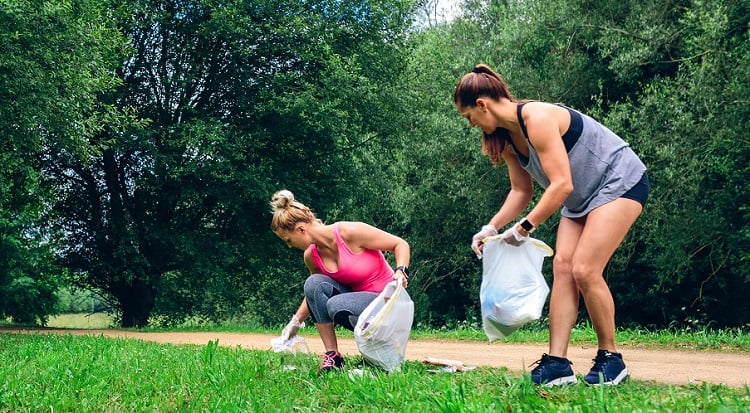The path to spiritual enlightenment is strewn with used toilet paper.
At least, that was my experience while hiking portions of the famed Camino de Santiago in Spain several years ago. Don’t get me wrong, there were plenty of majestic views during my trek, but I felt a bit disheartened about the evidence of heavy trail use in the form of litter.
Anyone who’s driven in America knows this is not just a European problem. A 2009 report by Keep America Beautiful estimates that each mile of American roadway contains 13,458 pieces of litter. And that doesn’t even include trash left along greenways and hiking trails.
Thankfully, the Swedes have come up with an innovative solution to pollution that’s becoming more popular in the U.S. Plogging, as it’s called, combines jogging with “plocka upp” (the Swedish phrase for “picking up”). It’s just what it sounds like: you simply pick up trash while out on a run.
This month, I did a quick plog in the name of research. I also spoke with a couple of local experts to get their thoughts on the eco-sport. Here are five things to know about plogging.
1. Plogging is Hard Work
Ready to shake up your running routine? Plogging is a great full-body workout, but it’s very different from jogging.
“Set your expectations that it’s going to be different than other runs you do,” said Katie Helbig of Big River Running Company in St. Louis. “You may not go as far or as fast, but you’ll enjoy other benefits like muscle work when you squat to pick up trash or are perhaps carrying a heavy trash bag.”
Start with a short route, so that you can build up stamina for frequent squats, bends, starts, and stops. You can set a mileage goal or, if you’re feeling adventurous, a target number of trash bags once you’re more experienced.
2. Bring Gloves (and a Sense of Adventure)
“I usually wear heavy-duty gloves for safety and because some of it is pretty gross,” said Tim Auer, a plogging enthusiast from Valley Park, Missouri. Some of Auer’s most frequent finds include used diapers, feminine hygiene products, and condoms, as well airline-size liquor bottles.
Auer has also lugged bumpers, rugs, and construction debris on his plogs, all of which are “fun to haul around!”
3. Consider Logistics
Auer can usually cover 4 to 6 miles per plogging session, collecting about four kitchen-sized trash bags of litter and some larger items that won’t fit in bags.
“Thankfully, there are a few dumpsters along the routes I run, so once I fill bags, I usually unload them and start over,” Auer said. “I’ve had a few instances where there haven’t been dumpsters close and my bag starts to give out, so I’ve had to leave it and then drive back over and haul it home when I finish.”
4. You’ll Set a Good Example
You may get a few odd looks and funny questions. During my brief plog in Forest Park, one passerby asked if I was serving time. Overall, though, I received very positive feedback. Auer has had the same experience.
“I have people stop and ask what I am doing and thank me for doing it,” Auer reports. Some of these strangers have even started plogging during their own walks.
And, speaking of setting an example, plogging is a great way to promote physical activity and environmental activism in kids. Helbig, who organized Earth Day group plogs for Big River Running last April, saw this firsthand.
“My own kids started picking up trash on their walk home from school on the day of the plogging event and even participated in the run,” Helbig said. “We had another customer bring his daughter, and she was really enthusiastic, picking up almost more pieces of trash than anyone else in the group.”
5. Every Little Bit Counts
It’s very gratifying to fill up a large trash bag on a plog, but small efforts during brief walks or jogs make an impact as well.
“Even just a plastic grocery bag full of trash is helping keep it out of the creeks, streams, and sewers,” Auer said.
So, next time you’re headed out for a walk or a jog, grab a bag (and some gloves) and get ready for some good, clean fun.
Author: Kimberly Yawitz is a regular contributor to Terrain Magazine


AWESOME IDEA!
I have been doing this in my local park for many years as I walk my dog.